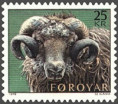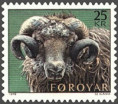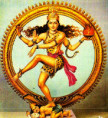MEETING OF WORLDS: Riccardo Arena´s Vavilon
Last night it was the full moon in Rome. I saw the moon's disk through our windows, its almost blinding glow made the trees´ slender trunks cast pitch black, sharp-cut shadows over the white ground. Some people find the moon's cool glow scary. My father's best friend, the Hungarian Miklós Fót, suffered from moon phobia. My mother once told me how she as a young and newly betrothed nurse walked through a nocturnal small town in company with my father and his friend. The moon was close to earth, and when my mother exclaimed that its light was romantic the already worried Miklós turned pale, stopped dead and then fled from the scene, probably home behind drawn curtains in his apartment.
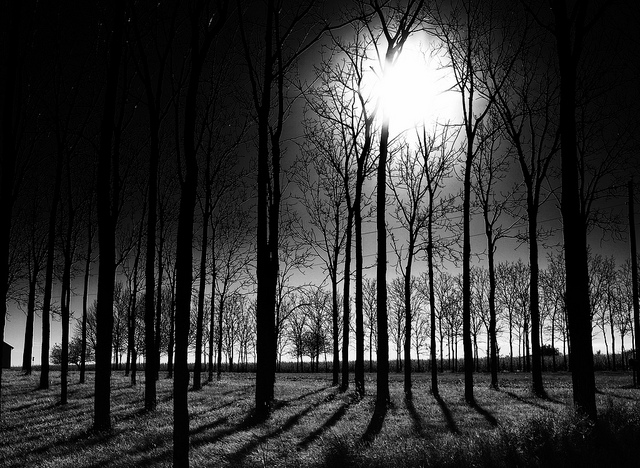
It is perhaps not surprising that the earth's constant companion has been worshiped as a deity, more mysterious and distant than the warm, life-giving, and substantially more powerful sun. The moon's weaker light which reigns over the night makes its presence more discreet, more mysterious than the sun, which with its overwhelming light reveals more than it conceals. The moon exposes its pale, mottled face when most of us are asleep and it is thus esteemed by predators and people with bad intentions. The moon is companion and beacon of dark forces.
Like the sun, the moon's regular habits reign over time. The white celestial body even seems to influence women's bodies. The moon's cycle that roughly covers 29.5 days and nights controls our months and seems to be linked to the menstrual cycle, which generally comprises 28 days and nights. Since it is non-pregnant, but yet fertile, women who menstruate the moon has become a symbol for both fertility and virginity and it is also believed to affect the vegetation.
The moon's varied nature, its pallor, apparent power over growth, water and women, has made people believe that it can also exert influence on our thinking. In several communities the moon has been connected with mental disorders, especially recurring anxiety attacks affecting bipolar and schizophrenic individuals, as well as the seizures of epileptics, a reason for the English designation of “crazy” people as lunatics. The moon shines over nomads´ trails crossing steppes, savannas and tundra, above ships on vast oceans and although twelve persons have walked on its surface, the moon does not cease to be a mysterious presence in our lives. Far from all of its secrets have been revealed.
In the northern realms, with sparse population, vast expanses of snow, long endless nights and dark oceans the firmament seems to be close to earth. Cloudless nights allow us to peer into cosmos´ infinity; intense stellar twinkling, the Milky Way´s white, flaming thoroughfare, and the scarred disc of the pale moon. In the north people are familiar with the lights of heaven, they navigate by them, and with trepidation they perceive their influence.

Between Russia and the Karelian Republic lays an inland sea, the White Sea, which like the Baltic Sea has brackish water. Seas that both unite and divide people. Around the White Sea live Finns, Karelians, Sami, Russians and Nenets, people who during millennia have divided and mixed their culture, religion and worldviews. Since ancient times, people have travelled across the White Sea. Along its shores and on its islands we find traces of beliefs that have long since been forgotten, notions shared by people thousands of years before Christ.

On the island of Bolshoi Zavatskty we find, for example, thirteen remarkable stone labyrinths and no less than 850 small pyramid-shaped piles of boulders. The mazes are concentrated to the western part, while most rock formations are found in the west. The labyrinths are by locals called Vavilons - Babylonians, but no one knows who made them, or for what purpose. There is a lot of speculation about these strange stone formations, not the least that they could be remnants of the lost Atlantis, but the most prevalent theory is that the labyrinths once were associated with rites connected with the shamans´, or deceased peoples´, travels to "the other side". The Zavatsky Island would then have been sacred ground, a border line between our world and the other world, something that brings us to the eastern shores of the White Sea, the Karelians´ realm, which stretches from the Arctic Circle down to Lake Ladoga, in the west it borders the country of their relatives –the Finnish people.
Until the 1500s, rune songs were sung in Finland and Karelia. They were ballads with a historical and religious content; epic descriptions of the exploits of legendary heroes, love songs and spells. The State supported Reformation was opposed to non-Christian traditions, the Sami religion was persecuted and Finnish rune songs banned. In remote areas, however, these songs lived on.

The medical doctor Elias Lönnrot (1802 - 1884) became during his travels in remote areas fascinated by the rune songs, sung in Finnish and Karelian. He recorded the oral poems and compiled them into an exciting epic, which he called Kalevala. While Russian folklorists on the southern and eastern shores of the White Sea collected Byliny tales, Russian epics about heroes and their demonic adversaries. Like the Finnish Kalevala has inspired writers, musicians and painters, Byliny did the same for their Russian counterparts.
The central theme of Kalevala is a power struggle between the dark Pohjola and the bright Kalevala. The stories may be understood against the background of the harsh life in the White Sea area. The tales often deal with mighty men trying to find rune songs that may help them to master skills like boatbuilding or forging, or influence other persons. Most skilled of all blacksmiths was Ilmarinen, who once crafted the sky without traces of either nails or hammers. Wiser than all living beings was Ilmarinen's friend and confidant - Väinämöinen. The friends, however, were not so triumphant in love.
Pohjola was home of eternal cold and wickedness. In this kingdom the World Tree found its roots, while its crown extended all the way up to Pohjantähti, the North Star. In Pohjola lived the powerful witch Louhi, Pohja´s Housekeeper, who was a shapeshifter and in her service had a vast horde of demons. She lived in the depths of Pohjola, in her Copper Mountain behind heavy, wrought-iron gates.

Like other men in the Kalevala, Väinämöinen and Ilmarinen were obsessed by their desire for a woman to share their lives with. The most beautiful women were to be found beyond the sea, in Pohjola´s misty cold. When a young woman who had been coveted by Väinämöinen killed herself, the old wizard went off to Pohojola to find a willing bride. On his way to the north Väinämöinen was mortally wounded and taken prisoner by the evil Louhi. In order to cure and relieve Väinämöinen, Louhi demanded that his friend Ilmarinen forged a sampo for her, as a reward the blacksmith would be given her daughter as wife – Pohja´s Maiden was the world's most beautiful woman. However, on his way home to Kalevala, Väinämöinen met Pohja´s Maiden and fell helplessly in love, though he kept this secret to Ilmarinen.
Like the Holy Grail the Sampo is an elusive object. It may described as a wealth producing mill, or cornucopia. The most important part of the Sampo was its lid, which might be interpreted as a symbol of the sky, arching over the fruitful earth. Without its lid the Sampo does not work properly. Obviously the object that Ilmarinen finally forged and bequeathed to Louhi was a kind of machine mirroring the generating power of nature.

Louhi delayed marrying her daughter to Ilmarinen and Väinämöinen took the opportunity to venture down into Tuonela, the reign of the dead, where he let himself be devoured by the mighty demon Antero Vipounen. In the giant´s stomach Väinämöinen forged iron and pained him until the demon agreed to teach him the coveted rune songs, which would enable Väinämöinen to build Kalevala´s best boat. After having learned these songs Väinämöinen forced the giant to throw him up.
With the boat he built, Väinämöinen sailed to Pohjola to woo Pohja´s Maiden, but the intimidating Louhi refused to give her stunning daughter to hoary Väinämöinen. After she had forced Ilmarinen to undergo a number of difficult, obviously impossible, trials she finally agreed that the master smith could marry Pohja´s Maiden.
When Ilmarinen´s beloved wife was murdered, he decided to join Väinämöinen on a venture to steal back the Sampo. Through his mighty rune singing Väinämöinen succeeded in anesthetizing Pohjola´s demonic inhabitants and the two cronies sailed away across the sea with the Sampo onboard. However, Luohi woke up and attacked the Sampo thieves in the shape of a huge bird of prey. They managed to wound her, but the Sampo was lost, sinking into the sea.

Väinämöinen could by Kalevala´s beaches salvage some remnants of the Sampo, but the lid was lost and Ilmarinen was not able to recreate the magical object. Enraged, Luohi stole and hid the sun and moon in her deep cave. Ilmarinen tried in vain to forge the heavenly bodies, but without light and heat they could not work. However, Väinämöinen managed to break into Luohi´s lair and thorugh his incantations he was able to force the mighty Pohoja Mistress to return heaven´s lights.
Kalevala tells about hands-on artists. Inventors and poets who were constantly on the lookout for, and fighting for something that lied beyond their everyday lives.

It is tempting to associate the Kalevala stories with the White Sea archipelago. Zavatsky is one of island constituting the Solovetsky archipelago. Zavatsky has with its enigmatic rock structures been interpreted as a juncture between two worlds and the island might thus be regarded as an important part of the Kalevala realm, where a meeting point between earth and heaven was assumed to be somewhere beyond the sea and where you could enter Pohjola or Tuonela, the chilly shadow world of the deceased, resembling the Hades of ancient Greeks.
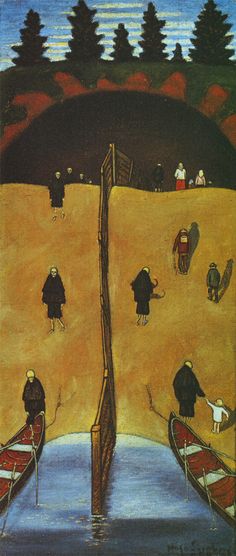
Actually, the southern part of the White Sea is not so chilly as the gloomy Pohjola and Tuonela. The sea lies just below the Arctic Circle and like the Northern parts of Scandinavia there are beyond its beaches and on its islands vast forests and swamps, lush flower meadows, lakes and granite cliffs. There are also plenty of mosquitoes and the summer nights are bright. Sometimes the temperature is more 20 ºC and it is possible to swim along the ocean's sandy beaches, though the winters are harsh and grim. During thousands of years the population on the islands and around the lake, called pomory, maritime people, by the Russians, have sustained themselves lived through fishing and kelp harvesting.

Kelp was used as a fertilizer, food for humans and fodder for animals. Nowadays. kelp is converted into pharmaceutical products, candy (as a substitute for gelatine), ice cream, pastries and especially iodine, which prevents goitre, but also it is also used in disinfectants, photographic film, halogen lamps and much more. However, not only industry and piety have characterized the Solvetsky Islands, evil and death have also had an abode there.
Behind the walls of grey stone blocks, with pointed, defensive towers, the great Solvetsky monastery rises its dazzling white walls, crowned with black onion domes. In 1436, the parents of the pious monk Zosimas died and he decided to withdraw from the world to live as a hermit on the secluded Solvetsky Island. Zosimas was soon joined by a small group of like-minded monks. A monastery soon grew up around the venerated Zosimas and after only twenty years it became the richest abbey in the entire Novgorod Republic.

The Novgorod Republic subsisted between the year 1010 and 1478, ranging from the Arctic Ocean in the north, the Baltic Sea in the west, and all the way to the Ural Mountains in the east. Through its trade with the German Hanseatic League, Novgorod had become a wealthy and powerful city. It traded furs, salt, dried fish, iron ore, walrus tusks and pearls to Germans, Danes and Swedes, products that often originated in the White Sea.
The Solvetsky monastery is surrounded by strong walls due to the fact that Karelia was a disputed region, where religious and economic interests caused fierce clashes between Swedes and Novgorodians. In the east, Karelians were Christianized by Russian Orthodox missionaries, while Swedish Catholics preached their faith in the western parts. Proselytizing zealots were protected by different warlords. Through the so-called treaty of Nöteborg in 1323, Karelia was finally divided between the Kingdom of Sweden and the Novgorod Republic. Nevertheless, conflicts between the two nations flared up periodically.
In 1571, the Swedes attacked the Solvetsky monastery, which after repeated attacks surrendered in 1579. In 1595, the Swedes pulled out from Solovky where the walls had been reinforced. The monastery remained one of the richest and most revered religious communities in Russia. During the late 1800s, 24,000 pilgrims came every year to the remote Solovky Island, which could only be reached after a more than two-hour long boat ride.

In 1923, the Solvetsky monastery was annexed by OGPU, the Joint State Political Directorate and turned it into a prison administered by SLON, Northern Camps of Special Purpose. Political prisoners were shipped to the isolated island accused for offending the Bolshevik state. They were "intellectual" criminals, members of political groupings that had been averse to the Bolsheviks, or "religious fanatics", i.e. devout individuals who had refused to renounce their religious faith and submit to the omnipotence of Soviet rule.
Between 1923 and 1939, the Bolshevik state apparatus sent an estimated 80 000 prisoners to Solovky, half of them came back alive, the others had been shot or perished through malnutrition, cold, torture and diseases. Solovky was the Soviet Union's first labour camp and became a model for the entire Gulag system, or in Solzhenitsyn´s words, the Mother of Gulag. This was mainly due to one of the prisoners - Aronovich Naftaly Frenkel, who originally came from Haifa in what was then Palestine. Frenkel had been arrested for "illegal border trade" and sentenced to ten years in Solovky. He observed the mismanagement and bad administration and suggested to the commandant, who curiously enough was named Eichmans, that he would allow the prisoners to work, instead of being locked up. Frenkel also recommended that the prisoners' rations ought to be calculated according to the amount and effectiveness of the work they had performed.
Naftaly Frenkel was pardoned, promoted to gaoler and later commandant of the entire Solovky lager. He then became one of the managers of the notorious slave labour on the White Sea Canal, which connected the Baltic Sea with the White Sea. It was excavated between 1931 and 1933 by more than 100,000 slave labourers, under brutal and primitive conditions which cost the lives of a fifth of the work force. Frenkel is seen on the far right of the picture below.

The Solovky Island was a perfect place for a labour camp. Chances for a successful escape were minimal and thus there was no need barbed wire. The island was covered with spruce and logging, as well as the harvesting and processing of seaweed, became the prisoners' main task, in addition – the algae could be eaten. Punishment and torture were facilitated by nature and climate – in summertime prisoners could be stripped, tied to tree trunks and merciless exposed to mosquitoes and other insects. The cold inspired incarceration in unheated stone chambers, where it could be less than 30 °C below zero, or headstrong prisoners were forced to wander naked back and forth in the deep snow.
Over the island's highest point rose Sekirka´s steeple, crowned by a lighthouse. The shrine of Sekirka had been built to provide a place for quiet meditation, but after the monks had been expelled, small solitary cells had been built within the interior. Here prisoners were locked up and forced to await what often would be their execution.
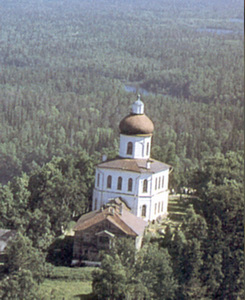
A fifth of Solovky Island´s inmates were women. They slept separated from the men, but were treated just as brutally as they. For example, a group of rebellious women were removed to a deserted island where they were left to die from cold and starvation.
In early 1934, the saintly Pavel Florensky arrived in Solovky, sentenced to ten years' hard labour for violating Article 54 of Stalin's criminal code, clauses ten and eleven: "agitation against the Soviet system" and "publication of propaganda material directed against the Soviet system." The verdict was based on book by Florensky that through various mathematical models presented a "geometric interpretation" of Einstein's Theory of General Relativity. He had speculated whether a geometric representation of imaginary numbers, predicted by a strict application of the theory of relativity on a body moving faster than light, could be used as to model the geometry of the Kingdom of God.
To me this appears as incomprehensible, but for the Stalinists it was enough to sentence Florensky to a painful disappearance. The harsh verdict was certainly due to the fact that Florensky was no ordinary scatter-brained maniac, but a highly respected scientist. Lev Trotsky had entrusted him with participation in the drafting of a national plan for electrification of the Soviet Union. Before sentencing Florensky the court had offered him to exile to Paris, together with his family, but he refused on the grounds that an acceptance of the terms would mean that he denied his Christian faith and was forced to renounce his actions. Instead Florensky pleaded guilty to all charges, declaring he was ready to sacrifice himself if he thus could avoid to unjustly accuse others.

When he arrived at Solovkij, Florensky was subjected to the same degrading treatment as other newly arrived prisoners; starvation food, sleep in unheated, common rooms, hard forest work and often unjustified punishments, all intended to break the prisoners and make them docile. Eventually he was transferred to a "laboratory" where Florensky and a few colleagues busied themselves with trying to find the best method for extracting iodine from kelp.
Florensky had since his childhood been keenly interested in the creation of electrical current from both static and dynamic processes. While on the Solovky Island, he carried out comprehensive studies of wave -, wind - and solar power. He was a dedicated explorer of all kind of natural phenomena, especially interested in the permafrost and ice´s ability to preserve organic material. Florensky also speculated about the beauty of ice and snow flakes, their ephemeral nature and the processes that created their geometric patterns.
Florensky was a scientist, an engineer, a mathematician and an aesthete, with a lively interest in art and music, constantly in search of the structure of divine creation. Above all, Florensky was a mystic who marvelled at the beauty of the Solvetsky archipelago and like others before him Florensky assumed he sensed a spiritual presence at the Solovky Island. Florensky´s apparent docility and dedication to his work convinced the lager authorities that they could allow him and a fellow prisoner to occasionally move outside the camp, to conduct field studies, or even lecture for various government agencies.

Florensky's refusal to abandon his Christian faith irritated the authorities. When they found that the content of his religiously coloured letters home had been disclosed outside the family circle and furthermore that his conversations with fellow prisoners had a "detrimental impact", Florensky was forbidden to write anything and eventually confined to the absolute silence of Sekirka´s isolation cells.
In 1937, Florensky was transferred to Leningrad where he during a secret trial was sentenced to death on December 8 and boarded a train with 500 other political prisoners. They arrived at an unknown destination, where all of them were executed. This was not known until 1998, previously Florensky's family had been told that he died of illness.
When I read about Florensky I was reminded of the Swedish scientist and mystic Emanuel Swedenborg (1668-1772). Like Florensky, Swedenborg was a mathematician fascinated by geometry, he was engaged with chemical experiments and an international authority on metallurgy. Swedenborg gradually became more and more engaged in religious speculations and pursued a theory able to explain the relationship between spirit and matter. His first attempt in this direction was the book de Infinito, About Infinity, in which he explained how the finite is related to the infinite and the body to the soul.

Like many contemporary philosophers, Swedenborg searched in the human anatomy for a nexus between soul and body. In 1744, he suffered a profound spiritual crisis and became a changed man, who nevertheless continued to believe that the spiritual realm and daily life were interconnected. Through his concept of correspondences Swedenborg claimed that he had solved the riddle of the linkage between the spirit world and everyday life. In one impressive book after another Swedenborg described his experiences and observations in the spiritual realm and applied his insights to our daily existing.
Florensky was also a practical man; engineer, chemist and mathematician.Just like the Swedish mystic he assumed that a logical, mechanical worldview was inadequate and sought a relationship between nature (matter), the spiritual, and the Kingdom of Heaven. With the help of mathematics Florensky tried to unite spiritual and scientific approaches. His studies took him beyond "the physical limitations of knowledge," and he began socializing with "spiritually inspired" musicians, artists and writers, not least Andrei Bely, the son of his mathematics professor.
In his poems and novels Bely had tried to combine music and literature, as well as eastern and western philosophy and spirituality. In his puzzling novel Petersburg, Bely lets an unfortunate and ridiculously posturing loser wander around in a fairly hysterical, humid and foggy Skt. Petersburg, just before the Revolution of 1905. The confused, young man, who is a victim of diverse influences and sometimes appears to confuse himself with the city he lives in, has by the revolutionaries been instructed to kill his own father.

Like Bely, Florensky was plagued by the decay he found around himself. For him sin was tantamount to a denial of the spiritual dimension, a delusion based on our pride, our self-centred clinging to the notion that man is the measure of everything. It's easy to waste a lifetime without a serious thought on God and the gifts He bestows upon us. To live in earnest you had to recognize that "I do not know" and be engaged in a continuous quest for God. Something that meant you must use science and studies to better appreciate how the divine manifests itself in our everyday life. Just as we strive for a woman's love, the scientist and a monk thirst for Sophia, the Divine Wisdom.

After having declined a university appointment as mathematician, Florensky turned to theology and was eventually ordained as a priest. "The all too-brilliant-successes of analysis have turned the mathematicians´ heads and they´ve got carried away." Florensky wanted to combine science, art and faith, mirroring God's mysterious Trinity – The Father, The Son and The Holy Spirit - united by Love. For Florensky this meant that he continued his scientific research, got married and had children with the woman he loved, while he served as a priest and immersed himself in the study of Russian icons and folk poetry. His colleagues at government laboratories and offices where amazed when he showed up wearing his clerical robes, especially within an increasingly tougher atheistic environment created by the Bolshevik regime.
In the image below, painted by the "spiritually inspired” artist Mikhail Nesterov, we see the priestly robed Florensky engaged in conversation with his friend Sergei Bulgakov, who was professor of economics, but later left his university career and, like Florensky, was ordained orthodox priest. Bulgakov was exiled in 1923 and then served as a professor at the emigre Russian theological institution in Paris.

When Bulgakov heard the news about Florensky's death he paid homage to his late friend by calling him a saint and writing that if anyone wanted to understand Florensky it was enough to contemplate "St. Andrej Rublev´s" icon The Old Testament Trinity, which in its perfection demonstrated what Florensky wanted to achieve - a perfect harmony between science, art and faith in God, realized in a blaze of other-worldly perfection.

It was art that made me write this blog. About a week ago I saw here in Rome Riccardo Arena´s exhibition Vavilon. Riccardo is a companion of Astrid, one of my oldest daughter's friends in Prague. I had met them a month before they returned to Rome for the premier of the exhibition. Then we had talked about art and mysticism, so for me it was especially interesting when Riccardo explained what had inspired his artwork and that was how I learned about Florensky and the spiritual geography of the Solvetsky archipelago.
Riccardo visited the archipelago in 2013 and has since studied Russian culture and especially cosmism, a kind of natural philosophy that sought to reconcile religion and science. Cosmism inspired a multitude of artists and writers, several of whom enthusiastic supporters of the Bolshevik October Revolution and the artistic movement that came to be called Proletkult. Artists with prominent figures such as Vladimir Mayakovsky and Kazimir Malevich wanted to create a completely new, dynamic aesthetics based on the industrial modernization of Russia's backward agricultural society. They intended to inspire a rejuvenating awareness, even fashioning “a new humankind”.

The concept cosmism had been created by Nikolai Fyodorov (1828-1903) who advocated that people would be completely changed through scientific methods, which among other things would lead to human immortality and a revival of the dead, a predecessor to what is now called cloning. Fyodorov advocated the application of religious thought in the scientific sphere. Cosmistic notions inspired Florenskij to imagine that along with the biosphere, the mass of all living organisms, there could also be a noosphere, which included all human knowledge that had been stored there for millennia. The concept was introduced by the mineralogist Vladimir Vernadsky (1863-1945) who declared that the noosphere (from the Greek νοῦς, mind and σφαῖρα sphere) was the third stage of the planet Tellus´s development after the emergence of the geosphere, consisting of inanimate matter and the biosphere, which is made up of the sum of biological life. The noosphere will eventually change everything and there are many who now equate the noosphere with cyberspace, which is in the process of changing the entire human existence.

While we walked through his exhibition Riccardo showed me a picture of a black sea, next to a similarly black canvas on which he with white text had written the names of the 23 lunar "seas". While we watched them Riccardo pointed out that even the moon's craters have different names, one of them is named after Florensky and another after Tsiolkovsky, who was also a cosmist. Nearby the canvas with the names of the moon seas was a stand-alone display on which a double glass presented lunar imagery together with the Gokstad Viking ship at Oslo´s Viking Ship Museum, Scandinavian ship barrows, other fusiformed objects, and a picture of Tsiolkovsky in his laboratory. Riccardo explained that the spindle-shaped so-called fusiform is common to several sea animals, neurons and cells, and that it was an important inspiration to Konstantin Tsiolkovsky (1857-1935) when he in his home built the world's first wind tunnel to explore aerodynamic laws and speculate about how future space crafts could be developed.

In 1903, Tsiolkovsky published his book Exploration of Outer Space by Means of Rocket Devices. It was the first scientific treatise dealing with the possibility of space flight. He introduced the idea of multistaged rockets, fuelled by liquid oxygen or liquid hydrogen. Tsiolkovsky was inspired by the development of grenades in the war industry, but it seems that his main inspiration was zeppelins and Jules Verne's novels, especially Robur-le-Conquerant, Robur the Conqueror, from 1886.

Already in 1852, the Frenchman Henri Giffard had designed a steam-powered, fusiformed balloon, but it was not able to fly against the wind, and when he in 1878 constructed a larger airship, equipped with a more powerful machine, it exploded in the air and it was not until 1900 that Ferdinand von Zeppelin was able to fly with an airship with a nearly identical shape as Giffard´s dirigible.

However, these vehicles were lighter than air. Jules Verne had in his novel a scene when a balloonist conference is interrupted by an engineer named Robur, who declares that "heavier than air" flying apparatuses are the future. In the novel, Robur´s airship is fusiformed and driven by propellers (“battery-powered, multirotor gyrodynes”), while Tsiolkovsky concluded that the only way to operate a flying vehicle heavier than air would be through liquid- or gas fuelled jet engines, working in the opposite direction to the vessel´s movement.

Tsiolkovsky´s cosmism was expressed through his belief that the colonization of space could be considered as a development of the noosphere and would eventually lead to the perfection of humanity, which end result would be immortality and a carefree existence. Later developers of the Russian rocket and space programme were inspired by Tsiolkovsky´s discoveries and many of them let themselves be enthused by his passion for using technology to improve the human constitution and possibilities to create a socialist utopia.

In his artwork, Riccardo Arena points to similarities between Tsiolkovsky´s rockets and the likewise fusilformed Viking ships. I came to think of whaling boats, which had the same shape in order to be equally able to move forward and backward. The vessels of Kalevala that sailed on the White Sea were also fusishaped.

The same form is linked to life and can be likened to the vagina. It can also be seen in Christian art as mandorlas, fish shaped aureoles which surround depictions of God, Christ or the Virgin Mary. A motif very common on icons.

In vodún I have come across so-called "thunder stones", which are said to provide strength to believers. Voodooists have told me that such stones can be picked up where lightning has struck and they put them on their altars, in bowls with oil. If you anoint yourself with this magically enhanced oil it is said to have a rejuvenating effect on your skin.

Central among his objects, Riccardo had placed a white structure within a circle of charcoal. It had been inspired by the bow of the Gokstad ship and the Monument to the Conquerors of Space outside Moscow´s cosmonaut museum. That Riccardo´s sculpture was placed within a circle of charcoal might be regarded as an evocation of the Solvetsky islands; to their reputation for spirituality, a nexus between different worlds, the base for the Tree of the World, and not the least their sad notoriety as the site for the Soviet Union´s first labour camps, where forests were felled, people murdered and trees burned to charcoal.
Riccardo´s exhibition also deals with the first cosmonauts and Soviet efforts to reach the moon. Beside the black canvas with the 23 names of lunar seas is a row with 23 points at varying heights. It symbolizes the notes that two Italian radio amateurs, the brothers Achille and Giovanni Judica Cordiglia, registered in 1960. When their mother, who was a pianist, heard the sequence of sounds she at once recognized the introduction to Modest Mussorgsky's opera Boris Godunov and the brothers soon realized that it was a code by which space stations in various parts of the Soviet Union announced that they were interconnected, just before a rocket launch could take place. The signals from each of the 23 stations created the introduction to Mussorgsky´s opera. When the brothers recognized the melody through their eavesdropping equipment they knew that a Soviet rocket launch would take place and they could then follow the spacecraft's journey around the Earth and record the sounds that came from it.

In this way they succeeded, as the only private persons outside the Soviet Union, to record unique and sometimes horrifying messages. For example, the brothers recorded the sounds of a manned craft coming off course and disappearing in May 1960. In November the same year they heard cries for help from a vessel that also disappeared from its orbit around the Earth. In February 1961, they heard a cosmonaut choking to death in his space capsule. In May 1961, a month after Gagarin's successful orbit around the Earth, they caught the cry for help from a space capsule that had lost control and in October the same year the same thing happened again. In November 1963, they could hear how a female cosmonaut screamed: "I'm hot! I'm hot!" just before her capsule caught fire.

The authenticity of the brothers´ recordings has been questioned by the Russians, but after watching a well-made TV programme with the two brothers, I Pirati Dello Spazio, Space Pirates, I am inclined to believe that everything is true. Riccardo had at an unreachable wall of the museum, which was blocked by charcoal, pinned up two small photographs of two of the cosmonauts assumed to have burned up or disappeared into outer space, likewise, he had beyond the charcoal belt attached small photographs of space debris swirling around the earth.
As you can imagine, I was fascinated and inspired by Riccardo´s exhibition, in addition to being aesthetically pleasing it did through its unique and thought provoking imagery bring the viewer with it, deep into Russian and universal spirituality. Telling about humankind´s efforts to reach into the unknown and how such a quest is supported by religion, science and technology. You also encounter the moon's cold sterility and man´s incomprehensible cruelty, coupled with our ability to create art and beauty, while spinning strange myths, marvelling at nature's unknowable infinity. By Riccardo's works the Solvetsky islands are revealed as a link between different dimensions, combining nature, mysticism and human endeavours.

Andrews, James T. (2009) Red Cosmos: K. E. Tsiolkovskii, Grandfather of Soviet Rocketry. College Station: Texas: A & M University Press. Applebaum, Anne (2004) Gulag: A History of the Soviet Camps. London: Penguin Books. Bely, Andrei (2011) Petersburg. London: Penguin Classics. Lamm, Martin (2000) Emanuel Swedenborg: The Development of His Thought (Swedenborg Studies). West Chester, PA: Swedenborg Foundation Publishers. Lönnrot, Elias (2009) The Kalevala, translated by Keith Bosley. Oxford: Oxford University Press. Pentikäinen, Juha, Y. (1999) Kalevala Mythology. Expanded Edition. Bloomington: Indiana University Press. Pyman, Avril (2010) Pavel Florensky, a Quiet Genius: The Tragic and Extraordinary Life of Russia's Unknown da Vinci. New York/London: Continuum. Solzhenitsyn, Aleksandr (1997) The Gulag Archipelago, 1918-1956: An Experiment in Literary Investigation, I - II. New York: Westview Press. Stroud, Rick (2009) The Book of the Moon. London: Walker Books. Verne, Jules (2006) Robur the Conquerer. Baltimore: Wildside Press.
Pirati dello spazio is available on https://www.youtube.com/watch?v=b4shg_43w28


